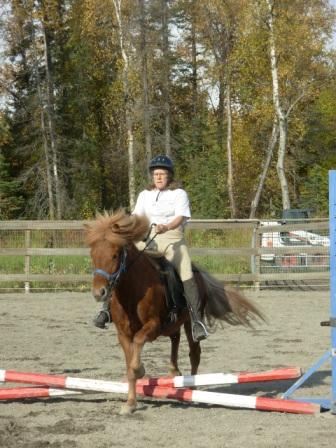
Home > About Us >Raudi > Lessons Learned One
Lessons Learned One
This, and the essays that follow, are about a series of riding lessons that I took in the winter of 2009. Palmer resident Dottie Kallum was my instructor, and I rode her horse Chester.
I had a lesson today, on Chester, in instructor Dottie Kallum’s arena. Chester is a chestnut Morgan, about 14’3; but because he’s stocky, he appears to be physically larger than he actually is.
I recently tended to him for Dottie, and thus learned that he likes routine and dislikes indecisiveness. I decided to ride Chester in lessons over the winter. My reasoning was that if I’m to teach Raudi new things, that I must know them myself.
Dottie tacked up Chester, and we talked about a book she recently lent me, Sylvia Loch’s The Classical Rider: Being at One with your Horse. I explained to Dottie that it’s an extremely dense book; she further agreed with me that it’s a book that anyone who is serious should read, repeatedly. One of the related things that Dottie and I talked about further was the importance of sending clear signals to the horse; otherwise, the animal merely becomes confused.
I figured that this was going to be the day that I’d shine as a rider, because I’d spent the last two weeks reading Loch, and therefore I had internalized much of what she’d written. I also figured that my having focused on getting physically fit was going to also contribute to a stellar ride.
What I learned (big thing) is that reading a book helps one understand what they ought to do when they are riding. But reading a book is not alone going to make one a top notch rider. For instance, reading Loch didn’t prepare me for what was to come, the physical difference that one feels when they go from riding a smaller, shorter strided horse, to riding a larger, longer strided horse.
Since this feeling was unnerving, I did what any sane person would do. I listened carefully to my instructor, and I followed her orders. After a few minutes, I realized that doing this alone wasn’t fully going to work. One simply can’t keep a tight outside rein, and do nothing else. One, instead, has to keep trying to put it all together, with the hope that they’ll eventually engage in that dance that goes on between horse and rider.
When finally, Dottie pointed out that I needed to make the connection between my shoulders and elbows, things began to click. I also started then to think in a less one-sided fashion, and as we were doing circles, I began to see how the outside elbow and shoulder could be used to keep Chester from falling out. (In the past, I’d shorten the inside rein, now the premise that this encourages falling in makes more sense to me.)
We also worked on my seat so as to bring about a more collected walk on Chester’s part. Here, again, when Dottie pointed out that I needed to make the connection between my perceived seat (that which I sit on) and my real seat (that which I sit upon as well as my upper legs) things really began to click. Chester started move in a less giraffe-like fashion; meaning, he lowered his head some and moved more smoothly. Then, and only then, was I able to move more freely to Dottie’s one, two, three, four. This then, seeing my shoulders and elbows, and bottom and legs as single, functioning entities, was a very useful big picture kind of thing.
At one point, Dottie suggested that I relax my tight seat and think of myself as a 300 pound cowboy. When she said this, I was able to do it. Her repeated exhortations to breathe were also quite useful – Chester relaxed and flicked his ears back and forth every time I did this.
We also worked some on trotting. This came at the exact moment that I was ready for it. Five minutes previously, and I would have begged off. But feeling how Chester had responded to the use of my seat had made me feel confident about what was to come. Dottie (wisely) fastened a strap around Chester’s neck, so that I would better be able to steady myself when he moved on. Too, the perceived movement of hands would be less so.
This was an excellent idea – the first few steps of Chester’s trot sent me bouncing way up into the air. The feeling was akin to being on a trampoline. We first, trotted down the length of the arena, walked the corner, and then trotted down the other side. Then, after a few go rounds, we trotted around the entire arena. My inside hand was holding onto the strap, and my outside hand was keeping the connection to the rein. All I can say is this worked.
We next did the same as above, in reverse. Here
Chester gave me something to think about, as he both sidled away from
the garden hose, and fell into the inside. I began to anticipate this,
and well knew that a few strides beforehand, that I was tensing up. The
last few times, I again focused on breathing, and this helped keep him
straight. Thinking ahead, focusing on the task at hand; these are, in
addition to the above, things I need to work on this week, as I practice
what I learned today, on Raudi and Tinni.
Alys
Pete
Raudi
Form
and Function
Gerjun's Decision
Bolting
Chafa Chafa
Clicker
Training
Trailer Training
Lessons 1
Lessons 2
Lessons 3
Lessons 4
Maresville
Minus Eight
Snow Day
Siggi
Tinni
Bootleg
Rainbow
Jenna
Goats
Chickens
